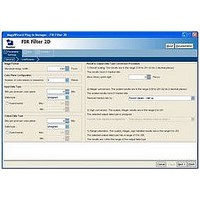IPSR-VIDEO Altera, IPSR-VIDEO Datasheet - Page 138

IPSR-VIDEO
Manufacturer Part Number
IPSR-VIDEO
Description
RENEWAL Of IPS-VIDEO
Manufacturer
Altera
Series
IP Suitesr
Datasheet
1.IPS-VIDEO.pdf
(202 pages)
Specifications of IPSR-VIDEO
Software Application
IP CORE, SUITES
Supported Families
Arria GX, Cyclone II, HardCopy II, Stratix II
Features
Common Avalon Streaming (Avalon-St) Interface And Avalon-St Video Protocol
Core Architecture
FPGA
Core Sub-architecture
Arria, Cyclone, Stratix
Rohs Compliant
NA
Lead Free Status / RoHS Status
na
- Current page: 138 of 202
- Download datasheet (6Mb)
5–58
Video and Image Processing Suite User Guide
Algorithmic Description
This section describes how the algorithmic operations of the polyphase scaler can be
modelled using a frame-based method. This description shows how the filter kernel is
applied and how coefficients are loaded, but is not intended to indicate how the
hardware of the scaler is designed.
The filtering part of the polyphase scaler works by passing a windowed sinc function
over the input data. For up scaling, this function performs interpolation. For down
scaling, it acts as a low-pass filter to remove high-frequency data that would cause
aliasing in the smaller output image.
During the filtering process, the mid-point of the sinc function should be at the mid-
point of the pixel to output. This is achieved be applying a phase shift to the filtering
function.
If a polyphase filter has N
square filter.
Counting the coordinate space of the filter from the top-left corner, (0, 0), the mid-
point of the filter lies at ((N
output pixel at (i, j), the mid-point of the kernel is placed at ( in
in
difference between the real and integer solutions to these equations determines the
position of the filter function during scaling.
The filter function is positioned over the real solution by adjusting the function’s
phase:
The results of the vertical filtering are then found by taking the set of coefficients from
phase
then divided down to fit in the number of bits chosen for the horizontal kernel. The
horizontal kernel is applied to the coefficients from phase
This value is then divided down to the output bit width before being written out as a
result.
Choosing and Loading Coefficients
The filter coefficients, which the polyphase mode of the scaler uses, may be specified
at compile time or at run time. At compile time, the coefficients can be either selected
from a set of Lanczos-windowed sinc functions, or loaded from a comma-separated
variable (CSV) file.
At run time they are specified by writing to the Avalon-MM slave control port
(Table 7–17 on page
When the coefficients are read at run time, they are checked once per frame and
double-buffered so that they can be updated as the MegaCore function processes
active data without causing corruption.
Figure 5–27 on page 5–59
(usually referred to as Lanczos 2) would be sampled for a 4-tap vertical filter.
j
are calculated using the algorithmic description equations on
j
and applying them to each column in the square filter. Each of these N
7–13).
shows how a 2-lobe Lanczos-windowed sinc function
v
vertical taps and N
v
–1)/2, (N
phase
phase
i
j
=
=
--------------------------------------------------------- -
h
------------------------------------------------------ -
i
-1)/2). As in the bilinear case, to produce an
j
max w
max h
w
h
in
in
%w
%h
h
in
in
horizontal taps, the filter is a N
out
out
w
h
out
out
P
P
v
h
i
, to produce a single value.
Chapter 5: Functional Descriptions
January 2011 Altera Corporation
i
û, in
page
j
û) where in
5–55. The
h
results is
v
× N
i
Scaler
and
h
Related parts for IPSR-VIDEO
Image
Part Number
Description
Manufacturer
Datasheet
Request
R

Part Number:
Description:
CYCLONE II STARTER KIT EP2C20N
Manufacturer:
Altera
Datasheet:

Part Number:
Description:
CPLD, EP610 Family, ECMOS Process, 300 Gates, 16 Macro Cells, 16 Reg., 16 User I/Os, 5V Supply, 35 Speed Grade, 24DIP
Manufacturer:
Altera Corporation
Datasheet:

Part Number:
Description:
CPLD, EP610 Family, ECMOS Process, 300 Gates, 16 Macro Cells, 16 Reg., 16 User I/Os, 5V Supply, 15 Speed Grade, 24DIP
Manufacturer:
Altera Corporation
Datasheet:

Part Number:
Description:
Manufacturer:
Altera Corporation
Datasheet:

Part Number:
Description:
CPLD, EP610 Family, ECMOS Process, 300 Gates, 16 Macro Cells, 16 Reg., 16 User I/Os, 5V Supply, 30 Speed Grade, 24DIP
Manufacturer:
Altera Corporation
Datasheet:

Part Number:
Description:
High-performance, low-power erasable programmable logic devices with 8 macrocells, 10ns
Manufacturer:
Altera Corporation
Datasheet:

Part Number:
Description:
High-performance, low-power erasable programmable logic devices with 8 macrocells, 7ns
Manufacturer:
Altera Corporation
Datasheet:

Part Number:
Description:
Classic EPLD
Manufacturer:
Altera Corporation
Datasheet:

Part Number:
Description:
High-performance, low-power erasable programmable logic devices with 8 macrocells, 10ns
Manufacturer:
Altera Corporation
Datasheet:

Part Number:
Description:
Manufacturer:
Altera Corporation
Datasheet:

Part Number:
Description:
Manufacturer:
Altera Corporation
Datasheet:











